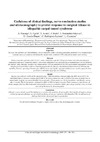Identificador persistente para citar o vincular este elemento:
https://accedacris.ulpgc.es/jspui/handle/10553/50123
| Título: | Usefulness of clinical findings, nerve conduction studies and ultrasonography to predict response to surgical release in idiopathic carpal tunnel syndrome | Autores/as: | Naranjo, Antonio Ojeda, Soledad Araña, Virginia Baeta, Pilar Fernández-Palacios, Javier García-Duque, Orlando Rodríguez-Lozano, Carlos Carmona, Loreto |
Clasificación UNESCO: | 32 Ciencias médicas | Palabras clave: | Carpal tunnel Neurophisiology Ultrasonography |
Fecha de publicación: | 2009 | Publicación seriada: | Clinical and Experimental Rheumatology | Resumen: | OBJECTIVES: To assess the usefulness of clinical findings, nerve conduction studies and ultrasonography performed by a rheumatologist to predict success in patients with idiopathic carpal tunnel syndrome (CTS) undergoing median nerve release. METHODS: Ninety consecutive patients with CTS (112 wrists) completed a specific CTS questionnaire and underwent physical examination and nerve conduction studies. Ultrasound examination was performed by a rheumatologist who was blind to any patient's data. Outcome variables were improvement >25% in symptoms of the CTS questionnaire and patient's overall satisfaction (5-point Likert scale) at 3 months postoperatively. Success was defined as improvement in both outcome variables. Receiver operating characteristics (ROC) curves and logistic regression analyses were used to assess the best predictive combination of preoperative findings. RESULTS: Success was achieved in 63% of the operated wrists. Utility parameters and area under the ROC curve (AUC) for individual findings was poor, ranging from 0.481 of the nerve conduction study to 0.634 of the cross-sectional area at tunnel outlet. Logistic regression identified the preoperative US parameters as the best predictive variables for success after 3 months. The best predictive combination (AUC=0.708) included a negative Phalen maneuver, plus absence of thenar atrophy, plus less than moderately abnormalities on nerve conduction studies plus a large maximal cross-sectional area along the tunnel by ultrasonography. CONCLUSION: Although cross-sectional area of the median nerve was the only predictor of success after three months of surgical release, isolated preoperative findings are not reliable predictors of success in patients with idiopathic CTS. A combination of findings that include ultrasound improves prediction. | URI: | https://accedacris.ulpgc.es/handle/10553/50123 | ISSN: | 0392-856X | Fuente: | Clinical and Experimental Rheumatology [ISSN 0392-856X], v. 27 (5), p. 786-793, (2009) |
| Colección: | Artículos |
Citas SCOPUSTM
30
actualizado el 08-jun-2025
Citas de WEB OF SCIENCETM
Citations
28
actualizado el 25-feb-2024
Visitas
166
actualizado el 23-sep-2024
Descargas
69
actualizado el 23-sep-2024
Google ScholarTM
Verifica
Comparte
Exporta metadatos
Los elementos en ULPGC accedaCRIS están protegidos por derechos de autor con todos los derechos reservados, a menos que se indique lo contrario.
